I want you to suspend your disbelief for a few moments and pretend that tech entrepreneurs and venture capitalists hadn’t co-opted the word disruption for their eye-roll inducing, money-making endeavours. What might we think about when we think of disruption if the likes of Uber, Amazon and Google simply didn’t exist? For us as both consumers of their products and services, and producers of data that further fuels those products, it’s helpful, from time to time, to imagine what the world might look like in their absence.
Our minds might turn to everyday forms of disruption, those moments where things go wrong. Those points in time where we need to find workarounds and use problem-solving skills to achieve what we set out to do in the first place.
The promise of technology is that we need never be disrupted again (don’t make promises you can’t keep). But failures often produce disruptions: trains run late and, in turn, so do we. Algorithms produce biases that impact real people and their wellbeing. Our credit cards get cloned and we need to go through administrative hoops to participate in the economy once more.
Harold Garfinkel studied everyday disruption in the mid-20th century by getting his students to carry out breaching experiments – public events (or stunts) designed to make things go wrong so that he could uncover how people expected things to go right.
Was this ethically dubious? Yes. Was this deeply fascinating? Also, yes. Sociologists, such as C. Wright Mills (1959), show us that understanding our expectations of everyday life relate to our expectations of how society should ideally function. Studying disruption in the mundane everyday helps us, as scholars, to interrogate what those expectations of a functioning society might be.
We want our lives to work in straightforward ways. Elizabeth Shove (2004) talks about this in more domestic terms, suggesting that technologically mediated everyday life in the Global North is oriented around ‘comfort, cleanliness and convenience’.
Disruption–as breakdown– makes the things and processes we take for granted, visible (Star 1999). Breakdown deals with the failure of an object; disruption is the impact of that breakdown on people, processes and other objects. When your train is delayed, you realise that there is a network of signalling technology, electricity and rails that holds the whole thing together. When your road is flooded, you realise that there is a weather pattern and an ecosystem holding the planet in delicate balance.
And yet, we prefer to have an existence where everything just works, where we are sold products that promise seamless experiences (again, more promises that can’t be kept). But we watch this convenient life fall apart the instant the internet goes down or the moment we are told to stay two metres away from our fellow citizens. We need to reconsider the role disruption plays in society; how its is encated, known, and conceived.
For instance, if disruption were personified, it would stand uncomfortably close to you and whisper into your ear, ‘Pay attention!’
Pay attention to your expectations. Who has been shaping them? Are they in your or your community’s best interests.
Think about how things might be otherwise.
Imagine another way.
As we navigate through the disruptions that 2020 has brought, that whisper becomes a shout: ‘PAY ATTENTION!’
Pay attention to your expectations. What do you really need to get by?
Look around to see who and what is really holding things together.
Pay attention to how things might be otherwise. What needs to happen in the now to avoid a future where disruption reigns?
Disruption on a grand scale highlights how much we rely on one another and often those overlooked or taken advantage of in the global economy. Big tech makes such claims of disruption that are not truly disruptive at all – more often than not they are a repackaging of products and processes to extract maximum profit. How does this distract us from the whisper of disruption in the world around us?
Author: Jessamy Perriam
References:
Garfinkel, H. (1984) Studies in Ethnomethodology. 2Rev Ed edition. Cambridge, UK: Polity Press.
Mills, C. W. (1959) The Sociological Imagination. Harmondsworth: Oxford University Press.
Shove, E. (2004) Comfort, Cleanliness and Convenience: The Social Organization of Normality. Oxford, England; New York: Bloomsbury Academic.
Star, S. L. (1999) ‘The Ethnography of Infrastructure’, American Behavioral Scientist, 43(3), pp. 377–391. doi: 10.1177/00027649921955326.
